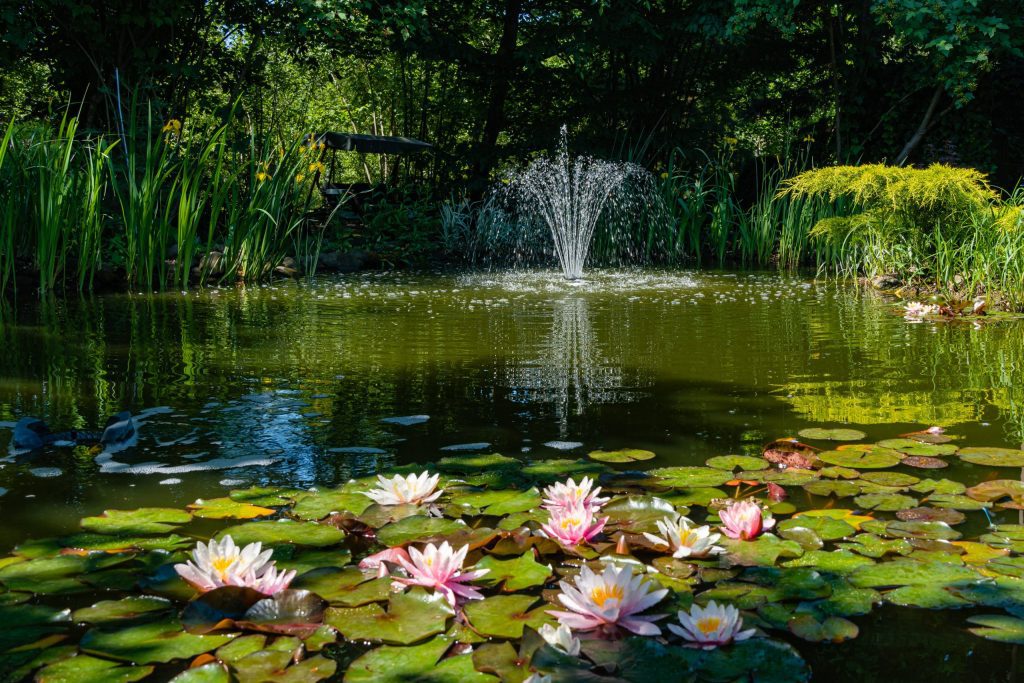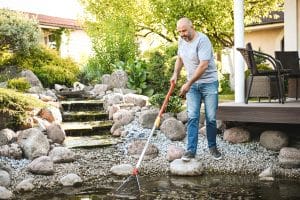
Top Steps for Pond Planning Permission: Ensure Your Project's Success
Planning a pond? Find out if you need pond planning permission and how to secure it. This article explains the key steps and local regulations you must know.
Key Takeaways
Understanding pond planning permission is crucial to ensure compliance with local regulations and environmental standards, particularly for larger ponds or those in conservation areas.
Proper site evaluation is essential for pond construction, focusing on soil type, drainage, and potential impacts on local wildlife to support biodiversity.
Ongoing maintenance, including managing invasive species and ensuring water quality, is vital for the long-term health and ecological balance of the pond ecosystem.
Understanding Pond Planning Permission

Before you start digging, understanding the intricacies of pond planning permission is crucial. This step is not just a legal formality but a crucial part of ensuring your pond complies with local regulations and environmental standards. Failing to secure the necessary permissions can lead to fines, forced removal of your pond, and potential damage to protected habitats.
Planning permission varies depending on the size and location of your pond. Generally, small garden ponds do not require planning permission unless they significantly impact drainage or designated habitats. However, larger ponds or those located in conservation areas often require formal permission to proceed. Consulting with your local planning authority helps confirm if planning permission is needed.
Local authorities have specific guidelines designed to protect the environment and ensure that new ponds do not negatively impact protected species. Reaching out to your local planning office ensures your project aligns with regulations. Moreover, consider the environmental impacts, like effects on nesting birds or existing habitats.
In the following subsections, we will delve deeper into when planning permission is needed, the role of local authority regulations, and the environmental considerations you must take into account.
When You Need Planning Permission
Planning permission is not always required, but knowing when you need it can save you from future headaches. Generally, permitted development rights allow you to construct small ponds for private enjoyment without formal planning permission, provided they do not affect the local environment. However, larger ponds, or those in designated areas like conservation zones or areas of outstanding natural beauty, typically require planning permission.
Seek confirmation from your local planning authority regarding the necessity of planning permission for your project. They can provide specific details about the legal requirements and help you assess the site’s potential for surface water and groundwater interaction, which might influence the need for permission.
Local Authority Regulations
Local authority regulations play a significant role in the pond planning process. Your local planning office and council will have specific guidelines that must be followed to ensure compliance with environmental and welfare considerations. For land designated as a Site of Special Scientific Interest (SSSI), checking the regulations is important. You may need to obtain consent before you dig a pond or lake.
Local councils are responsible for ensuring that pond construction does not significantly impact protected areas or species. Therefore, it is crucial to check with your local council for compliance with regulations before starting work on your pond project. This step ensures that your pond will be both legally compliant and environmentally friendly.
Environmental Considerations
Environmental considerations are a critical aspect of pond planning. The presence of certain species can lead to additional regulatory requirements. For example, in conservation areas, there may be restrictions to protect existing habitats when planning a pond. Check for signs of nesting birds before digging to avoid legal issues and harm to local wildlife.
Making your pond wildlife-friendly and minimizing negative impacts on the local environment is both a legal obligation and a moral responsibility. Protecting habitats and creating a good habitat for local wildlife will enhance the ecological value of your wildlife pond and provide a sanctuary for various species.
Evaluating Your Site for a Pond

Selecting the right site for your pond is crucial for its success. Ponds offer essential habitats for various wildlife, contributing significantly to biodiversity. However, not every site is suitable for pond construction. Evaluating your site involves understanding soil type, drainage, and the potential impact on local wildlife.
Creating ponds in diverse shapes, sizes, and depths enhances habitat variety, supporting more wildlife. Understanding soil type and drainage is crucial before starting pond construction. The presence of diverse underwater plant life is essential for attracting and supporting various animal species.
Next, we explore specific criteria for site assessment, the impact of pond construction on local wildlife, and possible restrictions in conservation areas.
Site Assessment Criteria
Begin site evaluation by understanding the interaction between surface water and groundwater and conducting contaminants testing to ensure suitability. Ideal soil types for ponds include clay and loam, while sandy or gravelly soils may not retain water effectively unless groundwater levels are adequate.
No-input grassland is recommended for creating ponds to maintain clean water, while peat soils should be avoided. Assessing water retention by digging trial pits in the area can help determine the feasibility of pond construction.
Impact on Local Wildlife
Creating a pond involves considering the impact on local wildlife. If protected species are present during pond planning, a Habitats Regulations Assessment is required. Avoid destroying existing wildlife when creating new ponds to preserve local ecosystems.
Supporting local ecosystems through pond design is vital for maintaining biodiversity. Ponds located in species-rich grassland, woodland, heathland, or wetlands are better suited for supporting wildlife. Additionally, seasonal ponds may reduce fish populations, providing a more favorable environment for amphibians and invertebrates.
Conservation Area Restrictions
Planning a pond in a conservation area often comes with specific limitations to protect existing ecosystems. Further consent from conservation authorities may be needed when planning a pond in such areas. These areas are environmentally significant, and restrictions are in place to protect their unique ecosystems.
Grasping these restrictions is critical for successful pond planning in conservation areas.
Designing Your Pond

Designing your garden pond is where creativity meets practicality. A well-designed pond creation must consider both aesthetic appeal and ecological health to foster vibrant aquatic life. Landscaping features can be created using excavated spoil to enhance the surrounding environment.
This section will cover size and depth considerations, biodiversity enhancement, and sustainable design practices, ensuring that your pond not only looks beautiful but also supports a thriving ecosystem.
Size and Depth Considerations
Ponds should typically be less than 2 hectares in size to be classified as ponds rather than lakes. Including a variety of depths, such as shallow ponds of 15-30 cm and sections deeper than 60 cm, enhances habitat diversity in an existing pond.
For optimal wildlife support, the pond should have a maximum depth of about 1 meter, balancing maintenance and ecological needs.
Biodiversity Enhancement
Enhancing biodiversity is a key aspect of pond design. Ponds and lakes serve as priority wildlife habitats that support a diverse array of freshwater species. Creating ponds in community greenspaces supports wildlife, offers habitats for freshwater species, and provides water sources for birds and mammals. Natural edges with gentle slopes and vegetation enhance habitat cover for aquatic life, promoting ecological diversity.
Creating connectivity between ponds with vegetation can help support various wildlife ponds species. Placing natural water sources near the pond enhances its ecological value and supports wildlife.
Sustainable Design Practices
Incorporating sustainable design practices reduces ecological footprints and maintains water quality. Utilizing locally sourced stone and clay for pond construction helps blend the pond with the natural surroundings. Biofiltration methods, such as aquatic plants and gravel beds, can help maintain water clarity and quality naturally. Regularly removing debris and organic matter from the pond surface minimizes nutrient buildup, preventing algal blooms and ensuring cleaner water.
Installing a natural wetland zone around the pond can effectively filter pollutants and contribute to overall water quality improvement.
Construction and Excavation Tips

Constructing your pond involves careful planning and execution. Reliable techniques in pond excavation are essential for maintaining stability. They also help in preventing erosion. Managing excavated materials properly protects the environment and aids in pond stabilization. Effective installation of pond liners maintains water quality and prevents leakage.
This section will provide practical advice on choosing the right excavation techniques, managing excavated materials, and installing liners.
Choosing the Right Excavation Techniques
Excavation should begin from the edges where the pond shape is marked, ensuring sides are sloped at approximately 45 degrees. An excavator is typically used for excavation in pond construction. Before digging, strip and remove the topsoil. The excavator for pond construction should be operated by an experienced operator.
Creating plant shelves around the pond supports aquatic vegetation without interfering with water flow.
Managing Excavated Material
Disposing of excavated material properly maintains local ecology and landscape aesthetics. Excavated spoil must be managed to avoid negative impacts on the landscape, with options like creating landscaping features or restoring disturbed areas. Removing spoil from the site is generally much more costly compared to other management options.
When spreading materials near the pond, avoid spreading material, especially topsoil, uphill of the pond.
Installing Liners and Ensuring Water Quality
Pond liners are essential for retaining water and maintaining clarity within the pond ecosystem. Pond liners are available in different materials. Common options include rubber and reinforced polyethylene. The primary purpose of pond liners is to prevent water loss and maintain clean water.
Properly installing pond liners ensures consistent water quality and ecosystem health.
Maintaining Your Pond Ecosystem

Maintaining your pond is an ongoing process that ensures its health and visual appeal. Ongoing maintenance keeps the pond healthy and visually appealing.
This section will cover plant and wildlife management, and water quality control.
Plant and Wildlife Management
New ponds provide a vital refuge for many freshwater plants and animals. To prevent the introduction of invasive species during pond construction, be careful to avoid introducing disease or invasive non-native species. Promptly managing invasive species prevents them from dominating and outcompeting native flora in pond ecosystems.
Invasive plants in a pond should be controlled to prevent competition with native species.
Water Quality Control
Maintaining water quality is essential for a healthy ecosystem, preventing algae blooms, and sustaining oxygen levels. Sediment accumulation can smother aquatic plants and reduce water depth, negatively impacting pond health.
Non-toxic materials and natural filtration methods support ecological balance and reduce harmful impacts on the pond’s environment.
Seasonal Maintenance Tips
Seasonal maintenance is crucial for keeping your pond in top condition throughout the year. Different seasons bring unique challenges and opportunities for pond care.
Following specific maintenance tips for each season ensures your pond remains healthy and vibrant.
Spring and Summer Care
Spring and summer are the ideal times to introduce new aquatic plants to your pond. The warmer water temperatures during these months encourage rapid growth, enhancing the pond’s biodiversity. Introducing new plants during mid-spring to early summer promotes healthy plant growth, contributing to a vibrant pond ecosystem.
Regularly topping up the pond with rainwater during hot weather maintains oxygen levels and supports fish health.
Autumn and Winter Preparation
Preparing your pond for the colder months is essential to maintain a healthy ecosystem. During autumn, clear away dead leaves and plant matter to prevent decomposition in the pond.
During winter, keep part of the pond unfrozen to provide oxygen access for fish. Using methods like floating a ball can keep part of the surface open, facilitating oxygen exchange. Effective winter preparation ensures the pond’s health and longevity, protecting aquatic life from freezing temperatures.
Summary
In summary, planning, constructing, and maintaining a pond involves meticulous attention to detail and a deep understanding of environmental impacts and regulations. From securing planning permission to designing a wildlife-friendly habitat and ensuring proper seasonal maintenance, each step is vital for the success of your pond project. By following these guidelines, you can create a beautiful and thriving pond that enhances your garden and supports local biodiversity. Now, it’s time to bring your vision to life and enjoy the myriad benefits of a well-planned pond!
Frequently Asked Questions
Is planning permission required for a pond?
Planning permission is generally not required for garden ponds, but it is advisable to verify this with your local authority, especially for larger ponds or public sites.
What soil types are best for pond construction?
Clay and loam are the most suitable soil types for pond construction, as they effectively retain water, whereas sandy or gravelly soils may require sufficient groundwater levels to prevent water loss.
How can I prevent algae blooms in my pond?
To prevent algae blooms in your pond, maintain water quality by regularly removing debris and employing natural filtration methods with non-toxic materials. This proactive approach is essential for a healthy aquatic ecosystem.
What are the benefits of creating a wildlife pond?
Creating a wildlife pond enhances biodiversity by providing crucial habitats for various species, thereby increasing the ecological value of your garden. This not only supports local wildlife but also contributes positively to the environment.
How can I ensure my pond remains healthy during winter?
To maintain your pond’s health during winter, keep part of the surface unfrozen for fish oxygenation and remove any debris before the season begins. This will help prevent detrimental decomposition in the water.



